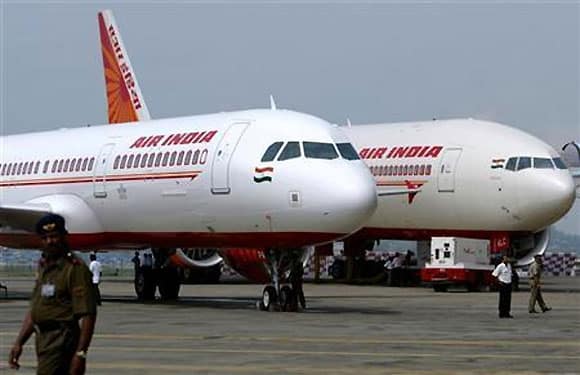Aerospace
Tata chairman says interested in bidding for Air India

NEW DELHI (Reuters) – India’s Tata conglomerate is interested in bidding for state-owned Air India as the group needs to increase the sizes of its aviation business, its boss told television channel CNBC TV18 in an interview on Monday.
Tata would “definitely look” at Air India once the government finalised the privatisation process, N. Chandrasekaran, chairman of Tata group’s holding company Tata Sons, told the channel.
He said Tata, which already has two small airline joint ventures in India, one with Singapore Airlines and the other with Malaysia’s AirAsia Bhd, was still not clear about what a sale would look like.
The government has not said whether it will sell all or parts of Air India and what it might do about the loss-making airline’s debt burden of $8.5 billion.
“We still don’t have all the details,” Chandrasekaran said. “We have two airlines, both are subscale. I feel scale is important.”
When asked whether Tata had spoken to Singapore Airlines about its interest in bidding for Air India, Chandrasekaran said: “Do you think I would have not?”
Tata’s interest in Air India has been reported but Chandrasekaran had not spoken publicly about a possible bid.
Prime Minister Narendra Modi’s cabinet in June gave the go-ahead to sell Air India, which has received $3.6 billion since 2012 in state aid.
Last month the government invited bids to appoint financial and legal advisors for the sale process.
Some companies including low-cost Indian carrier IndiGo, owned by InterGlobe Aviation, ground handling company Bird Group and Turkey’s Celebi Aviation Holdings have expressed an interest in buying some of Air India’s various businesses.
Courtesy : Reuters

Aerospace
Boeing Transfers Rocket Stage to NASA, Paving Way for Human Moon Mission

Boeing has achieved a significant milestone by providing NASA with the second core stage of the Space Launch System (SLS) rocket.
This crucial component, crafted at NASA’s Michoud Assembly Facility (MAF), is set to propel the Artemis II crew into lunar orbit, marking humanity’s return to deep space after a 50-year hiatus.
The monumental Boeing-built rocket stage, the largest element of the Artemis II mission, will embark on a journey aboard the Pegasus barge, traveling 900 miles to NASA’s Kennedy Space Center.
Comparison of two legendary aircraft B777x vs B747 aircraft:Click here
Upon arrival, it will be meticulously integrated with other essential Artemis II components, including the upper stage, solid rocket boosters, and NASA’s Orion spacecraft within the iconic Vehicle Assembly Building. This intricate integration process is a vital step toward the eagerly anticipated Artemis II launch, slated for 2025.
“Boeing-built products helped land humankind on the moon in 1969, and we’re proud to continue that legacy through the Artemis generation,” remarked Dave Dutcher, vice president and program manager for Boeing’s SLS program. “Together, with NASA and our industry partners and suppliers, we are building the world’s most capable rocket and paving the way to deep space through America’s rocket factory in New Orleans.”
NASA, Lockheed Martin Reveal X-59 Quiet Supersonic Aircraft:Click here
The delivery of Core Stage 2 marks a significant achievement in the evolution of the SLS rocket. Towering over 200 feet and powered by four RS-25 engines, this core stage, coupled with two solid-fueled booster rockets, will generate a staggering 8.8 million pounds of thrust. This immense power is crucial to launching Artemis II and future missions into the vast expanse of space.
The SLS rocket stands unparalleled in its capability to transport both crew and substantial cargo to the moon and beyond in a single launch. Its extraordinary capacity will facilitate the delivery of human-rated spacecraft, habitats, and scientific missions to destinations including the moon and Mars, ushering in a new era of space exploration.
-

 Travel1 week ago
Travel1 week agoAir India to Expand US Operations with Three New Routes After a Decade
-

 Travel2 weeks ago
Travel2 weeks agoWhy We Should Avoid These Stamps in a Passport
-

 Airlines1 month ago
Airlines1 month agoInvestigations Reveal Fake Chinese Titanium in Boeing and Airbus Jets
-

 Tech4 weeks ago
Tech4 weeks agoChina’s CATL Plans 1,800-Mile Electric Plane Launch by 2027
-

 Airport3 days ago
Airport3 days agoTop 10 Largest Airports in the World by Size
-

 Aerospace4 weeks ago
Aerospace4 weeks agoChina’s Fighter Jets Turn Wings into Autonomous Drones
-

 Airlines4 days ago
Airlines4 days agoAir India Rolls Out A350s for Delhi-New York JFK and Newark Routes
-

 Defence3 weeks ago
Defence3 weeks agoBoeing Enhances Chinook with New Engines and Block II Upgrades at $96 Million







